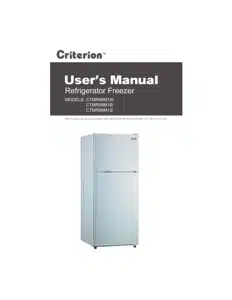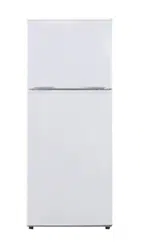Documents: Go to download!
User Manual
- User Manual - (English)
- Technical Specifications - (English)
- Warranty - (English)

- Main Components
- Important Safety Instructions
- Installation Instructions
- Operating Your Refrigerator
- Freezer Compartment Operation
- Care and Maintenance
- Changing the Reversible Door
- Troubleshooting Guide
Table of contents
User manual Refrigerator
-244100.png)
Main Components
-148973.png)
- Freezer temperature control knob
- Refrigerator temperature control
- Refrigerator Compartment shelf
- Vegetable Bin
- Adjustable Feet
- Freezer Compartment Shelf
- Freezer Door Rail
- Lamp Switch
- Simple Rack
Important Safety Instructions
IMPORTANT
To reduce the risk of fire, electrical shock, or injury follow these basic precautions when using your refrigerator.
DANGER: Risk of child entrapment. To avoid the possibility of child entrapment, please take the following precautions before you dispose of your refrigerator.
- Remove all doors.
- Leave shelves in place so children may not easily climb in.
- Never allow children to play with, operate, or crawl inside the refrigerator.
Do not store or use gasoline or any flammable vapors and liquids in the vicinity of this refrigerator.
All refrigeration products contain refrigerants, which under the guidelines of federal law must be removed before disposal. It is the consumer’s responsibility to comply with federal and local regulations when disposing of this product.
Installation Instructions
Before Using Your Refrigerator
- Remove the exterior and interior packing.
- Before connecting the refrigerator to the power source, let it stand upright for approximately 4 hours. This will reduce the possibility of a malfunction in the cooling system from improper handling during transportation.
- Clean the interior surface with lukewarm water using a soft cloth.
Location
- Do not recess or build-in. This appliance is designed to be free standing only.
- Allow 5 inches clearance space between the back and sides of the refrigerator, which allows the proper air ventilation.
- Avoid Installation:
- On weak surfaces unable to support refrigerator when fully loaded.
- In direct sunlight and sources of heat (stove, heater, radiator, etc.). Ambient temperature below 50°F or above 85°F will hinder the performance of this appliance.
- In moist areas.
- In garage. This unit is not designed for any type of outside installation.
- In moving vehicle. This unit is not designed to be installed in an RV or used with an inverter. This unit is intended for household use only.
Installing Your Refrigerator
- Adjust the leveling feet to keep the refrigerator level.
- Plug the refrigerator into dedicated, properly installed-grounded wall outlet. Do not under any circumstances cut or remove the third (ground) prong from the power cord.
- After plugging the appliance into a wall outlet, turn the unit on and allow the unit to cool down for 24 hours before placing food in the refrigerator or freezer compartment.
Electrical Connection
Warning
Improper use of the grounded plug can result in the risk of electrical shock. If the power cord is damaged, have it replaced by an authorized service center.
This refrigerator should be properly grounded for your safety. The power cord of this refrigerator is equipped with a three-prong plug which mates with standard three prong wall outlets to minimize the possibility of electrical shock.
Do not, under any circumstances, cut or remove the third ground prong from the power cord supplied.
This refrigerator requires a standard 115/120 Volt A.C. ~/60Hz electrical outlet with three-prong ground.
This refrigerator is not designed to be used with an inverter.
The cord should be secured behind the refrigerator and not left exposed or dangling to prevent accidental injury.
Never unplug the refrigerator by pulling the power cord. Always grip the plug firmly and pull straight out from the receptacle.
Do not use an extension cord with this appliance. If the power cord is too short, have a qualified electrician or service technician install an outlet near the appliance. Use of an extension cord can negatively affect the performance of the unit.
Operating Your Refrigerator
Temperature Control
The temperature control is located inside the refrigerator and in the freezer compartment on some models. The temperature is factory preset to provide satisfactory food storage temperatures. However, the temperature control is adjustable.
To adjust the temperature colder in the refrigerator compartment, press the SET button on the control panel so that the display light shifts to a higher number. “1” is the warmest setting and “5” is the coldest. To adjust the temperature colder in the freezer compartment, move the Freezer Control knob towards the maximum setting. After each movement of either control, allow 24 hours for the unit to adjust. If the unit is still not cold enough, repeat until desired temperature is achieved.
To adjust the temperature warmer in the refrigerator compartment, press the SET button on the control panel so that the display light shifts to a lower number. To adjust the temperature warmer in the freezer compartment, move the Freezer Control knob towards the minimum setting. After each movement of either control, allow 24 hours for the unit to adjust. If the unit is still not warm enough, repeat until desired temperature is achieved.
-285333.png)
NOTE
If the unit is unplugged or loses power; you must wait 3 to 5 minutes before restarting the unit. If you attempt to restart before this time delay, the refrigerator may not start.
Changing the interior LED light
1. Using a flat blade screwdriver or a fingertip, push in the latch to release the lamp cover, then remove it
-905527.png)
2. Unscrew the LED light bulb from the lamp socket, then replace it with a new LED light bulb.
3. Reinstall the lamp cover.
Freezer Compartment Operation
Temperature Control
Your refrigerator has one control for regulating the temperature in the freezer compartment. The freezer temperature control is located on the freezer compartment’s interior back panel. For the best performance, leave the freezer control at the midpoint and adjust the refrigerator compartment temperature control. Adjust the freezer control one increment at a time until the desired temperature is reached.
-583158.png)
NOTE
Do not store canned foods or food stored in glass containers in the freezer compartment.
The Freezer Compartment
This compartment is designed for the long-term storage of frozen food. The storage life of frozen foods varies and the recommended storage time should not be exceeded. Place frozen food into the freezer as quickly as possible after purchase. If there are instructions on the packet, carefully follow these instructions regarding storage times.
Care and Maintenance
Cleaning Your Refrigerator
- Disconnect the electrical unit from the wall outlet.
- Clean interior and parts with a cloth soaked in lukewarm water and baking soda solution. A solution of 2 tablespoons baking soda to a quart of water will clean and neutralize odors. Rinse and wipe dry.
- Be sure to keep the door gasket (seal) clean to keep the unit running efficiently.
- The outside of the refrigerator should be cleaned with a warm damp cloth and mild detergent. Do not use harsh or abrasive cleaners.
- Never clean refrigerator parts with flammable fluids. The fumes can create a fire hazard.
Vacation Time
- For long vacations, remove all food. Then, unplug the electrical cord from the wall outlet.
- Clean the interior and leave doors open to avoid possible odor or mold formation.
- Use extreme caution. The unit should not be accessible to child’s play.
Moving Your Refrigerator
- Disconnect the electrical cord from the wall outlet.
- Remove all the food and securely tape down all loose items such as shelves, drawers, and doors.
- Be sure the refrigerator stays in the upright position during transportation.
Energy Saving Tips
- The refrigerator should be located in the coolest area of the room, away from heat producing appliances or heating ducts, and out of the direct sunlight.
- Let hot foods cool to room temperature before placing in the refrigerator.
- Be sure to wrap foods properly, and wipe containers dry before placing them in the refrigerator. This cuts down on frost build-up inside the refrigerator.
- Organize and label food to reduce door openings and extended searches
Changing the Reversible Door
Before reversing the door swing, ensure the appliance is unplugged and empty. Provide additional support for the doors while hinges are being removed. Do not depend on the door magnets to hold the door in place. It is recommended that two people perform this task. DO NOT lay the appliance completely flat as this may damage the coolant system.
Door parts
-911633.png)
Included parts
-902202.png)
Step 1
-847112.png)
Remove top hinge cover. Unscrew and remove the top hinge and top hinge washer. Save the screws.
Step 2
-361218.png)
Lift the freezer door up and away from the appliance
Step 3
-50134.png)
Unscrew and remove the middle hinge and middle hinge washer. Reserve the screws. Lift the refrigerator door up and away from the appliance.
Step 4
-49225.png)
Unscrew and remove the bottom right hinge. Save the screws. Remove screw covers from opposite corner (left) and cover exposed holes (right). Attach bottom left hinge with the saved screws.
Step 5
-959588.png)
Remove right pin assemblies from the bottom of the freezer and refrigerator doors. On the opposite side, attach the replacement pin assemblies (located in the plastic bag with the Use and Care Manual) with a philips screwdriver.
Note: You must re-use the screws from the pin assemblies that are removed in this step when attaching the new assemblies
Step 6
-727699.png)
Place the refrigerator door on the bottom left hinge. Ensure the door is aligned horizontally and vertically. Attach middle hinge to top (left) of refrigerator door, attach washer to the back of hinge, align with holes and affix to middle beam with saved screws. Fasten with philips screwdriver (not included).
Step 7
-75120.png)
Place the freezer door on the middle hinge. Ensure that the door is aligned horizontally and vertically, and that the gasket seals on all sides before attaching the top hinge. Attach the top hinge and replace the hinge cover.
Troubleshooting Guide
You can solve many common refrigerator problems easily, saving you the cost of a possible service call. Try the suggestions below to see if you can solve the problem before calling for service.
| Problem | Possible Causes |
| Refrigerator does not operate |
|
| Compressor turns on and off |
|
| Refrigerator compartments are too warm |
|
| Vibrating or rattling (slight vibration is normal) |
|
| Temperature of external refrigerator surface is warm |
|
| Moisture collects inside the refrigerator |
|
| Moisture forms on outside of refrigerator |
|
| Bubbling or gurgling sounds (like boiling water) |
|
| Popping or cracking sounds when compressor comes on |
|
| The door will not close properly |
|
See other models: CBC115CE2S MRF-541W CTMR21M1W CTMR145A1W CCR312DCE2S
